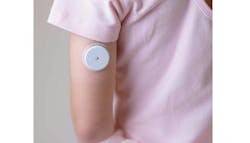Members can download this article in PDF format.
What you’ll learn:
- The main differences between Bluetooth LE, RFID, and NFC, and how all three of these technologies are now improving product security in healthcare and safeguarding patient information, among other benefits.
- The distinct advantages of Bluetooth LE, RFID, and NFC in specific healthcare applications, including patient monitoring, security, and inventory management.
- The power of integrating these technologies to create a more efficient and secure digitalized healthcare ecosystem.
The healthcare landscape is evolving rapidly, driven by advances in technology and a growing demand for more efficient, patient-focused medical solutions. Aging populations and the increasing prevalence of chronic diseases like diabetes, cardiovascular problems, and respiratory conditions are straining healthcare systems.1 In response, the "Internet of Medical Things" (IoMT) has emerged, connecting an expanding array of devices and sensors to gather real-time data that can help revolutionize healthcare.
The IoMT tackles healthcare challenges by enhancing safety, security, remote monitoring, patient self-care, and personalized therapies. Connectivity is key, making device and patient data security paramount. Vital wireless communication technologies comprise Bluetooth Low Energy (Bluetooth LE), radio-frequency identification (RFID), and near-field communications (NFC), and each contribute to a secure ecosystem of smart medical devices and medications.
Enhancing Healthcare Through Wireless Technology
The benefits of RFID, NFC, and Bluetooth LE technologies extend beyond enhancing security for medical devices. They also contribute to improving general patient safety and operational efficiency within the healthcare and pharmaceutical sectors.
These technologies play a pivotal role for smart medical devices and medicines. The integration of comprehensive product authentication and user authorization features help to manage the secure lifecycle of connected devices, assisting in the protection against cyberattacks. Sensitive patient data ought to be protected to ensure its integrity and confidentiality. This safeguards patient information, treatment effectiveness, and overall healthcare system integrity.
In the battle against counterfeit medicines and medical consumables,2 RFID and NFC offer protection along the entire supply chain, from point of manufacture right up to the delivery to the patient. By providing a robust traceability system with the ability to identify units and share cloud-based aggregation data, they help verify product originality, provenance, and guarantee patient safety.
Product authentication in pharmaceuticals and medical devices can be significantly enhanced using NFC crypto-secure tags. Authentication performs enhanced security checks based on a tag’s data and credentials, and authorization can confirm rightful access to a device, its application, and data. Using NFC tags can bring patients into the process, with easy authentication of products before purchase or use, via smartphones.
RFID and NFC can track medical assets and supplies in hospitals, which is crucial for accurate, efficient inventory management and monitoring expiration dates. Surgical tools with embedded durable tags can also be tracked to ensure availability, sterilization status, and efficient inventory management. Smart cabinets or fridges with embedded readers can automatically record when tagged items are placed in, taken out of, or returned to a storage unit and, when further equipped with sensors, can accurately control temperature.
Moreover, NFC and Bluetooth LE are able to help patients participate in self-monitoring and self-medication programs. Patients can easily access product information and instructions, or update a digital diary, using their smartphone.
Connected devices can send data directly to a smartphone via Bluetooth or patients could employ one-tap NFC. Closed-loop systems can automate communication between medical devices equipped with NFC readers and tagged consumables (e.g., injectors, inhalers), preventing the use of wrong, counterfeit, or expired consumables, and auto-configure devices with right settings.
Devices equipped with sensor technology and linked to tracking software can help patients digitally monitor and manage medication intake and minimize non-adherence. They can further opt-in to share their data with clinicians for remote monitoring.
On-body wearables featuring Bluetooth LE provide continuous monitoring capabilities of multiple body parameters and vital signs. Bluetooth LE enables the automatic alerting of these monitored parameters to a patient, family, and caregivers. A constant stream of accurate and reliable data for monitoring or precise control of therapy can be transmitted wirelessly via Bluetooth LE with minimal disruption to users’ daily activities.
Understanding the differences between Bluetooth LE, RFID, and NFC, and their distinct advantages, is vital for creating secure IoMT devices for a range of different applications. This knowledge enables engineers to develop complementary solutions that improve patient care, security, and operational efficiency.
What is Bluetooth Low Energy?
Bluetooth LE is a wireless communication technology introduced in 2010 as part of Bluetooth version 4.0. Bluetooth LE operates within a 10 m range, while Bluetooth 5.0 can extend up to 40 m. It transmits data over the 2.4-GHz spectrum with a maximum speed of 2 Mb/s.
Bluetooth LE is deployed on virtually every smartphone, enabling efficient bidirectional data exchange. One of its most significant advantages is ultra-low power consumption, making it possible for low-power devices to last for over four years on a single battery. Data transfer with a Bluetooth LE chip requires an energy source, though. It can’t operate in a purely energy-harvesting mode.
The Role of RAIN RFID Technology
RAIN RFID, a subset of RFID technology, uses the EPC Gen 2 protocol. It operates in the UHF (ultra-high frequency) band between 860 and 960 MHz. One of the key benefits of RAIN RFID is that it’s a passive technology, so there’s no need for a battery. It boasts an impressive operating range, extending up to 10 m. It can swiftly identify numerous items, handling hundreds of items per second, even without direct line-of-sight.
The technology’s extended memory capabilities also enable more information to be recorded throughout the supply-chain journey. Some variants of RAIN RFID provide enhanced security through cryptographically protected authentication functionality.
Near-Field-Communication Usage in Healthcare
NFC, a subset of RFID, is a short-range wireless communication technology with an operating range limited to less than 10 cm, which is even shorter with mobile phones. It functions on the principle of magnetic-field induction, transmitting data at 13.56 MHz (see figure).
NFC facilitates bidirectional data exchange without the need for pairing. It’s a passive technology, meaning NFC tags don’t need batteries and are powered by the active reader field from smartphones or built-in reader devices. This feature makes NFC suitable for various battery-free applications.
Moreover, NFC can ensure secure data and communication, if using enhanced cryptography to guarantee authenticity, confidentiality, and integrity of stored or transmitted data, making it a trusted choice for secure transactions and data exchange.
Connected tags are versatile devices for use in or on a system with an electrical system interface to connect to, such as an external sensor or microcontroller. In medical devices, NFC can be leveraged to read logged data or live measurements with a mobile device, or control a specific condition such as temperature or pressure during usage.
Comparing IoMT Technologies: Benefits of Bluetooth LE, NFC, and RAIN RFID
In the realm of IoMT, each of these different technologies offer distinct advantages. Bluetooth LE excels in creating compact, enduring wearable medical devices and sensors. These can seamlessly transmit real-time data to smartphones, enhancing patient monitoring. NFC, despite its limited range, improves security by requiring close proximity for authentication. This feature enables stringent access control, suiting it for medical environments where tight security is necessary.
On the other hand, RAIN RFID is a powerful tool for bulk item tracking. As with Bluetooth LE and NFC, RAIN RFID doesn’t require line-of-sight reading. Adaptable Electronic Product Code (EPC) memory also permits the addition of crucial data during the supply-chain journey, making it indispensable in logistics and inventory management.
Hybrid HF (high frequency) RFID combines data exchange in the vicinity range of up to 1.5 m, using HF readers, with NFC phone compatibility in close range of a few centimeters. It can thus be applied in logistical applications such as smart cabinets, packing boxes, or asset trays, as well as NFC operations for secure, device-to-consumable communication or smartphone-based user support.
Matching the Right Wireless Technologies to Healthcare Needs
In the healthcare sector, it’s important to understand the strengths and limitations of each type of wireless communication technology to understand how to use them to their best advantage. For instance, Bluetooth LE’s merit lies in a range of wearable applications that require regular transmission of data. It can be used in smart inhalers, smart skin patches, and vital signs monitoring, for example.
RAIN RFID is indispensable for real-time medicine and medical supply-chain traceability and inventory stock management. It provides precise tracking of pharmaceuticals, medical supplies, and equipment.
NFC has a broad range of applications in healthcare, including therapy adherence monitoring to ensure patients follow prescribed regimens. NFC can verify the authenticity and history of medicines and devices, securely manage digital product identities and certificates, as well as play a vital role in sensor-based wound care and fluid management (e.g., catheter bags). Through smart medical devices, NFC helps to support condition sensing and data logging, and enables patient and healthcare professional authentication with access rights.
Integrating IoMT Technologies to Improve Patient Care
Combining RAIN RFID, NFC and Bluetooth LE technologies together in various IoMT solutions, these technologies can contribute to more efficient and secure healthcare operations. Their use helps accelerate the digitalization of healthcare in various real-world use cases by creating “digital twins” of physical devices, medicines, consumables, and equipment. The digital information is automatically and contactlessly captured, read, controlled, and either stored locally on a device and uploaded to the cloud, or processed locally on the device itself.
Many use cases benefit from a complementary approach to these technologies. In device and pharmaceutical manufacturing, they enable precise product tracking, thus enhancing process control, and transparency in the supply chain. Clinical trials can benefit from real-time medication dosage tracking, improving patient adherence to therapy and enabling remote monitoring with corrective actions by doctors.
Furthermore, healthcare facilities can optimize inventory management, automate replenishment, and reduce costs and human error. Medical-device lifecycle management also improves with zero-power end-of-line configuration, secure firmware updates, maintenance, recalls, and end-of-life management.
By integrating and combining these wireless communication technologies in the right way, the IoMT ecosystem can unlock its full potential, paving the way for innovative healthcare solutions. Ultimately, the integration of Bluetooth LE, NFC, and RAIN RFID technologies controls product and patient safety, streamlines device and medication management, and fosters a more secure and efficient digitalized healthcare ecosystem—both for patients and the healthcare industry as a whole.
References
1. Atella V, Piano Mortari A, Kopinska J, Belotti F, Lapi F, Cricelli C, Fontana L., “Trends in age-related disease burden and healthcare utilization,” Aging Cell. Feb. 2019.
2. World Health Organization, “1 in 10 medical products in developing countries is substandard or falsified,” Nov. 28, 2017.




